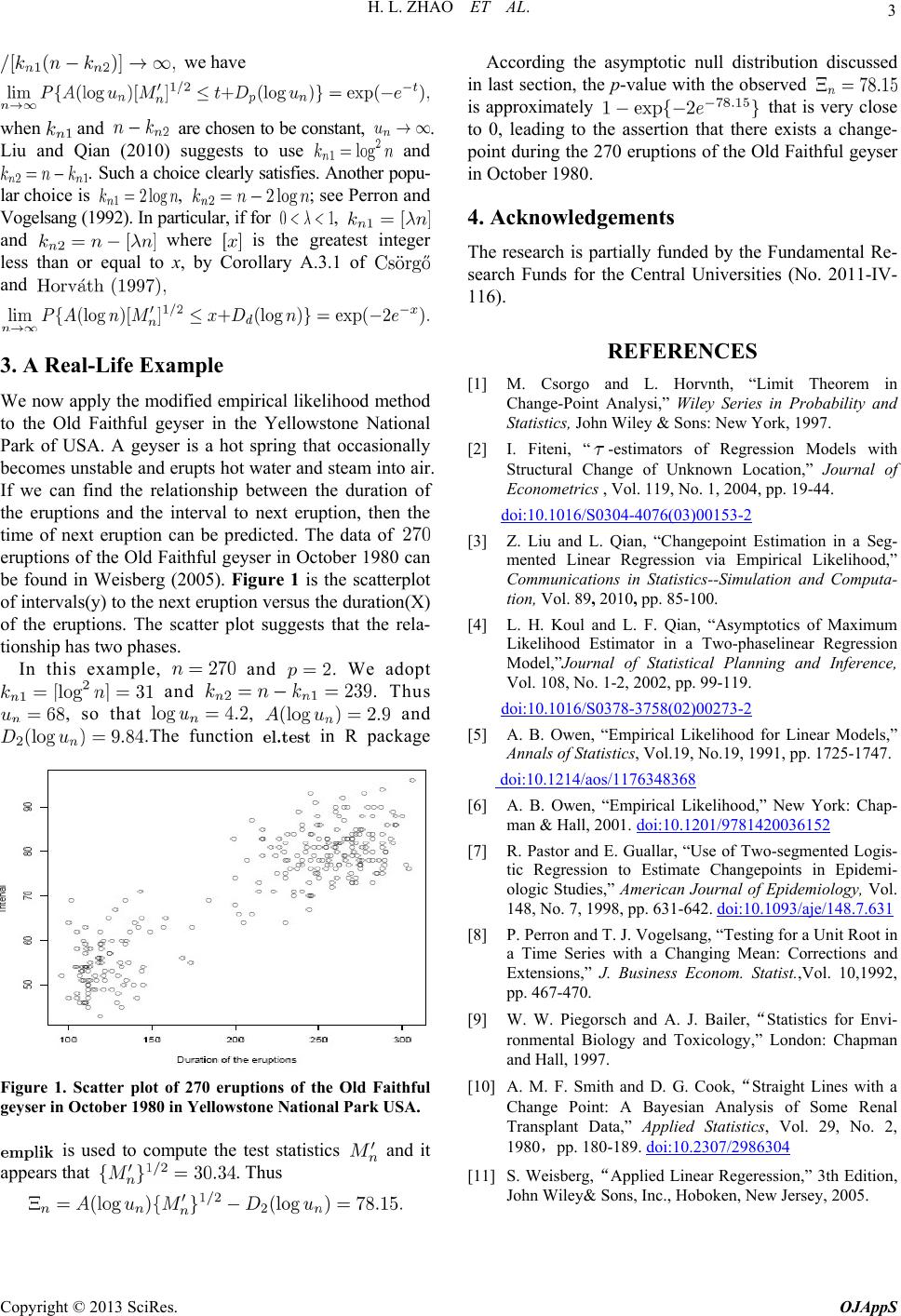
H. L. ZHAO ET AL.
Copyright © 2013 SciRes. OJAppS
3
According the asymptotic null distribution discussed
in last section, the p-value with the observed
is approximately that is very close
to 0, leading to the assertion that there exists a change-
point during the 270 eruptions of the Old Faithful geyser
in October 1980.
we have
when and are chosen to be constant, .
Liu and Qian (2010) suggests to use and
. Such a choice clearly satisfies. Another popu-
lar choice is , ; see Perron and
Vogelsang (1992). In p ar ticu l ar, if for ,
and where is the greatest integer
less than or equal to x, by Corollary A.3.1 of
and
4. Acknowledgements
The research is partially funded by the Fundamental Re-
search Funds for the Central Universities (No. 2011-IV-
116).
REFERENCES
3. A Real-Life Example [1] M. Csorgo and L. Horvnth, “Limit Theorem in
Change-Point Analysi,” Wiley Series in Probability and
Statistics, John Wiley & Sons: New York, 1997.
We now apply the modified empirical likelihood method
to the Old Faithful geyser in the Yellowstone National
Park of USA. A geyser is a hot spring that occasionally
becomes unstable and erupts hot water and steam into air.
If we can find the relationship between the duration of
the eruptions and the interval to next eruption, then the
time of next eruption can be predicted. The data of
eruptions of the Old Faithful geyser in October 1980 can
be found in Weisberg (2005). Figure 1 is the scatterplot
of intervals(y) to the next eruption versus the duration(X)
of the eruptions. The scatter plot suggests that the rela-
tionship has two phases.
[2] I. Fiteni, “-estimators of Regression Models with
Structural Change of Unknown Location,” Journal of
Econometrics , Vol. 119, No. 1, 2004, pp. 19-44.
doi:10.1016/S0304-4076(03)00153-2
[3] Z. Liu and L. Qian, “Changepoint Estimation in a Seg-
mented Linear Regression via Empirical Likelihood,”
Communications in Statistics--Simulation and Computa-
tion, Vol. 89, 2010, pp. 85-100.
[4] L. H. Koul and L. F. Qian, “Asymptotics of Maximum
Likelihood Estimator in a Two-phaselinear Regression
Model,”Journal of Statistical Planning and Inference,
Vol. 108, No. 1-2, 2002, pp. 99-119.
doi:10.1016/S0378-3758(02)00273-2
In this example, and . We adopt
and . Thus
, so that , and
.The function in R package [5] A. B. Owen, “Empirical Likelihood for Linear Models,”
Annals of Statistics, Vol.19, No.19, 1991, pp. 1725-1747.
doi:10.1214/aos/1176348368
[6] A. B. Owen, “Empirical Likelihood,” New York: Chap-
man & Hall, 2001. doi:10.1201/9781420036152
[7] R. Pastor and E. Guallar, “Use of Two-segmented Logis-
tic Regression to Estimate Changepoints in Epidemi-
ologic Studies,” American Journal of Epidemiology, Vol.
148, No. 7, 1998, pp. 631-642. doi:10.1093/aje/148.7.631
[8] P. Perron and T. J. Vogelsang, “Testing for a Unit Root in
a Time Series with a Changing Mean: Corrections and
Extensions,” J. Business Econom. Statist.,Vol. 10,1992,
pp. 467-470.
[9] W. W. Piegorsch and A. J. Bailer,“Statistics for Envi-
ronmental Biology and Toxicology,” London: Chapman
and Hall, 1997.
[10] A. M. F. Smith and D. G. Cook,“Straight Lines with a
Change Point: A Bayesian Analysis of Some Renal
Transplant Data,” Applied Statistics, Vol. 29, No. 2,
1980,pp. 180-189. doi:10.2307/2986304
Figure 1. Scatter plot of 270 eruptions of the Old Faithful
geyser in October 1980 in Yellowstone National Park USA.
is used to compute the test statistics and it
appears that . Thus [11] S. Weisberg,“Applied Linear Regeression,” 3th Edition,
John Wiley& Sons, Inc., Hoboken, New Jersey, 2005.